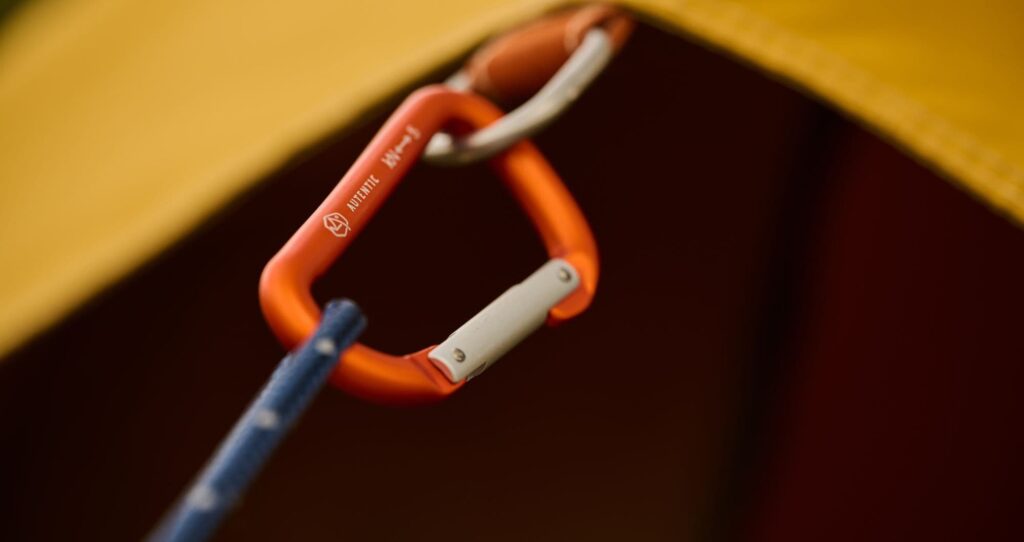

FAQ
FAQ
LOOKING FOR SOME HELP?
Click on the topic below to be guided to the answer to your question.
Don’t find what you are looking for? Get in touch!
LOOKING FOR SOME HELP?
Click on the topic below to be guided to the answer to your question.
Don’t find what you are looking for? Get in touch!
SETUP
Each Autentic glamping tent is accompanied by comprehensive step-by-step setup instructions and useful tips to facilitate setup. In case you misplace them, you can easily download them again from the dedicated page of your tent.
Below are some tips that can be helpful when setting up your glamping tent:
- Glamping spot
-
- Choose a flat and level area for your glamping tent’s setup.
- Place your glamping tent on higher ground to prevent water pooling during rain.
- Ensure that your glamping spot has enough space to accommodate the entire footprint of your glamping bell tent, including the guylines.
- Look out for any sharp objects, tree roots, twigs, or stones that may affect the stability or comfort of your tent. Also, be aware of any overhanging branches.
- Avoid positioning the tent with the openings (windows and doors) facing the wind, as strong gusts could turn your tent into a flying object. Instead, position the tent so that the wind blows on the back of it.
-
- Protect your tent
-
- To prolong the life of your glamping tent’s groundsheet, simply place a plastic tarpaulin underneath it.
- Use the provided base plates to prevent damage to your tent’s groundsheet and fabric.
-
- Pitching
-
- Make sure that everything that zips is zipped up before tensioning your glamping tent.
- Make sure everything is properly stretched so water can drain off fluently when the tent is set up.
- The guylines should always be perfectly aligned with the seams of the tent’s roof.
- Pitch your tent’s pegs firmly in the ground at a 90° angle.
-
The setup time for a glamping tent varies depending on its size. The Autentic Little Bell Tent can be set up by 1 person in just 20 minutes, while the larger Billy-Joe Double Bell Tent may require 2 hours with two to three people. All our glamping bell tents feature user-friendly tent parts such as colour-coded carabiners and easy-to-assemble frames, making the setup process easier and quicker for you. Once set up, you can enjoy them for an extended period of time.
You’ll find clear setup instructions for each Autentic glamping tent, both within the product packaging and on the corresponding website page of your tent. We highly recommend carefully reading the provided instructions to ensure a proper setup.

© @theforest_th
When you purchase an Autentic glamping tent, the following items are included as standard:
-
- Tent
- Groundsheet
- Pole(s) and frame(s)
- Ground pegs
- Guylines
- Hammer for the bell tents of the Dream Collection and Supreme Collection
- Repair tape
- Carabiners
- Setup instructions
Please note that optional bell tent accessories, such as short guy poles, inner liners and dividers, large center pole plates, heavy-duty center poles, and shock absorbers, are optional and therefore not included as standard with the glamping tent.
Building permit requirements for setting up a glamping tent vary depending on local regulations and jurisdiction. In some areas, obtaining a building permit may be necessary, while in others it may not be required.
It’s therefore essential to check with your local authorities, such as the city or county planning department, to determine if a building permit is necessary for setting up a glamping tent on your property.
All Autentic Bell Tents are supplied with a complete peg set. If you are camping in a flat or grassy area, you can certainly set up your bell tent directly on the ground.
Overall, we recommend installing your glamping bell tent on a wooden platform as it can provide a level and stable surface for the tent, which is important for ensuring that the tent remains upright and in good condition. It can also help to protect the tent from moisture, which can be particularly important if you plan to use your bell tent in wet or humid conditions. In addition, a wooden platform can provide a more comfortable and luxurious camping experience.
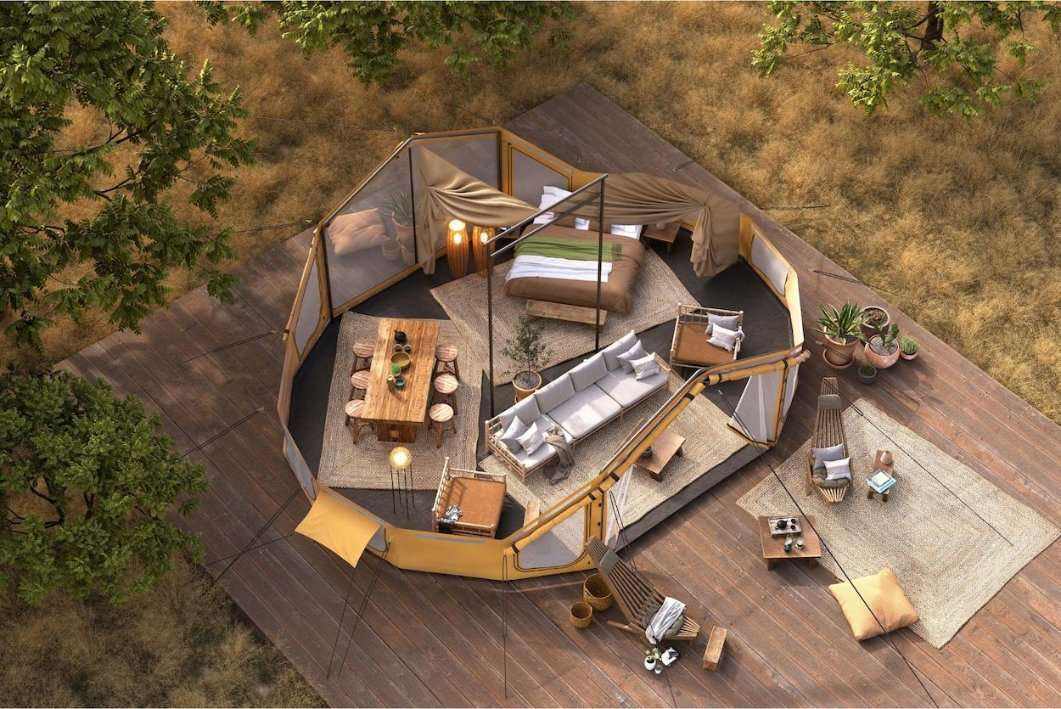
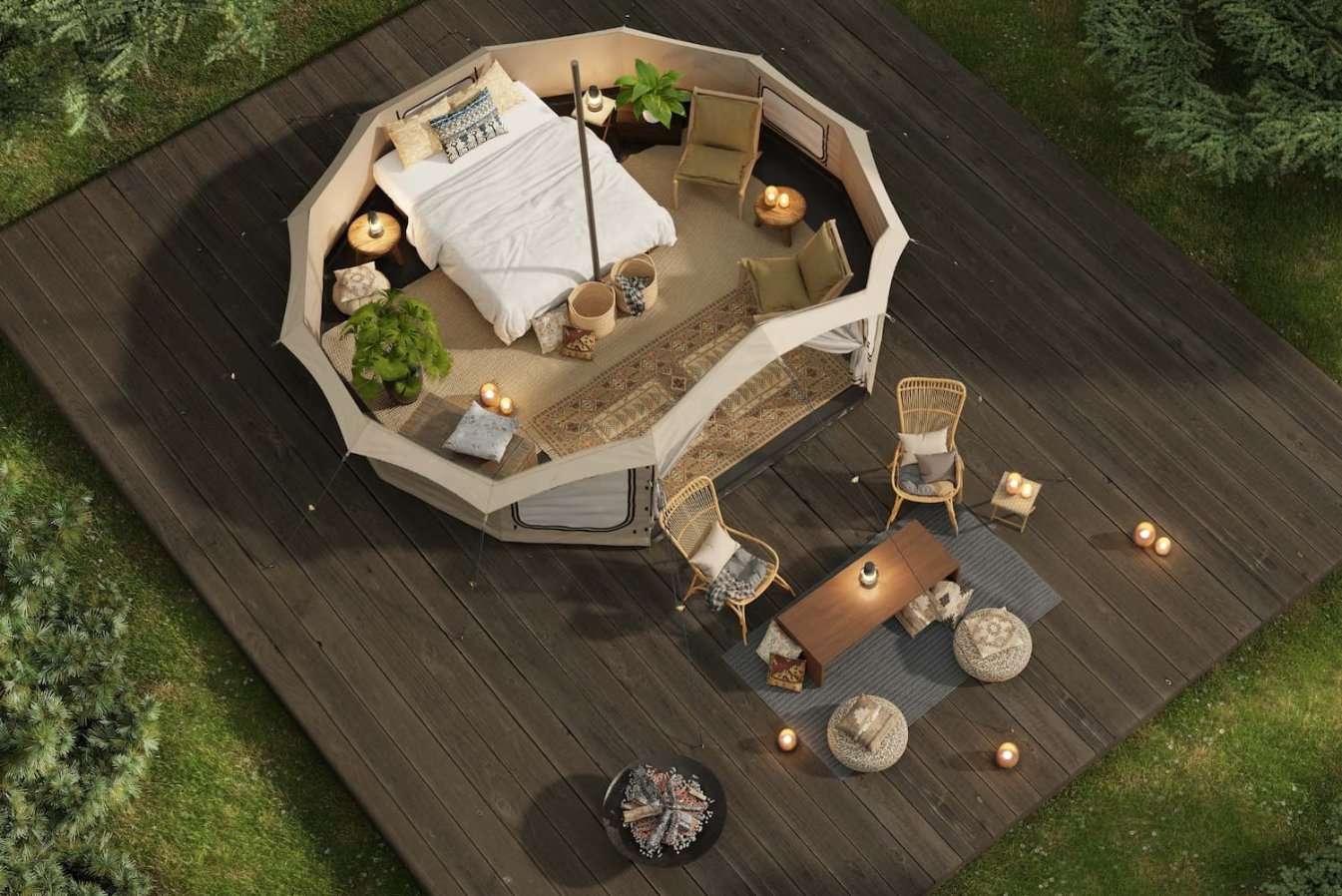
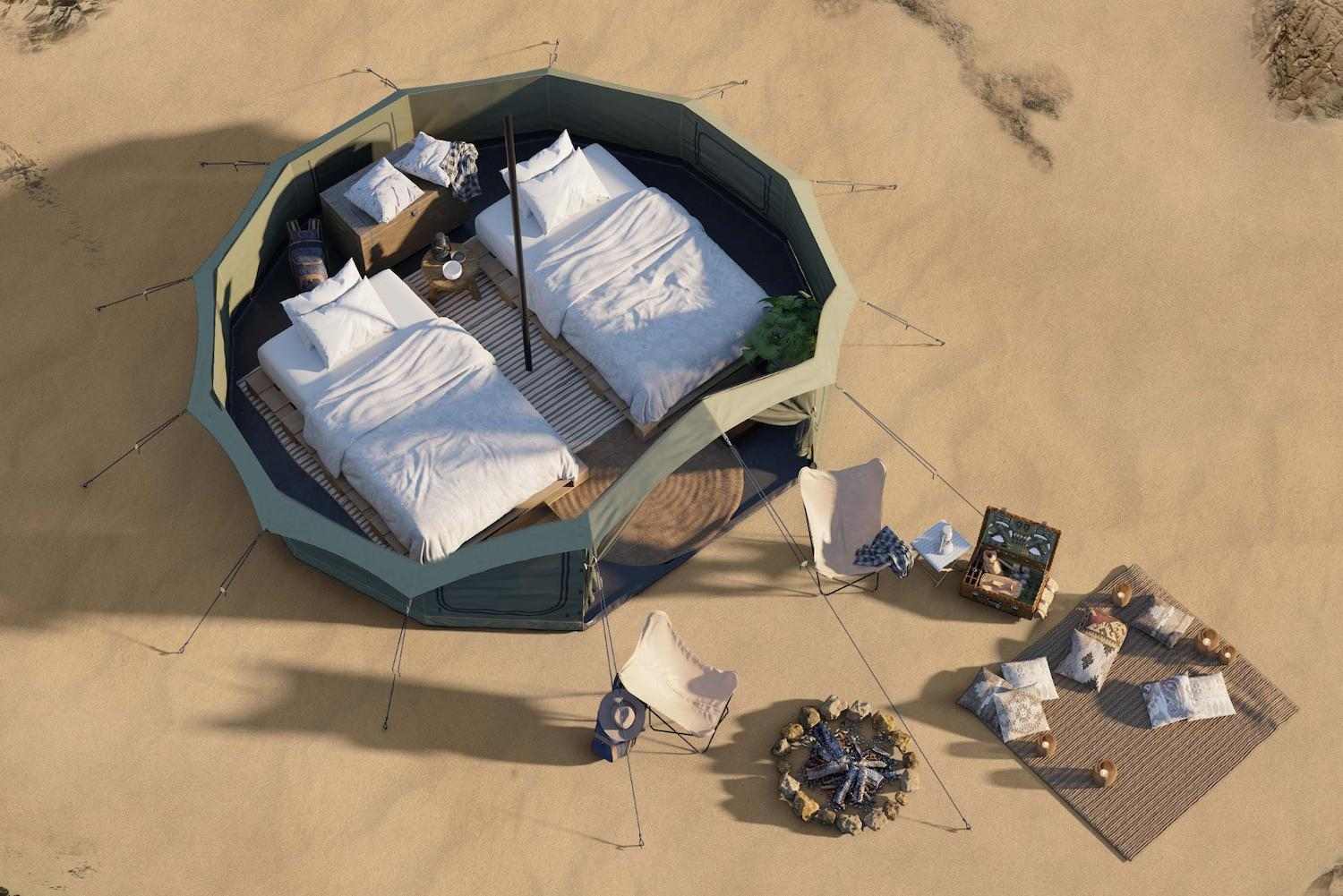
The required surface area for your bell tent varies depending on its size and whether you use Short Guy Poles during setup. The following illustrations display the minimum surface area needed for bell tents with and without Short Guy Poles.
When Short Guy Poles are employed on the tent walls, they enable a reduction in the guyline distance from 180 cm to the absolute minimum of 50 cm. For optimal stability, particularly with a sufficiently large surface area, it is recommended to maintain a guyline distance of 75 cm when utilizing Short Guy Poles.
It’s important to note that the inclusion of Short Guy Poles doesn’t impact the guyline distance for the three long guylines positioned at the doors. The Billy-Joe Double Bell 7.2 has a guyline distance of 250 cm, while the Jack Bell 5.2, Jay Bell 4.4, Essential Bell 5.2, and Essential Bell 4.4 maintain a guyline distance of 200 cm.
-
-
- Jay Bell Tent 4.4
Covered tent surface: 4.14 x 4.45 m
Minimum required surface for a setup with Short Guy Poles: 6.64 x 5.45 m
Minimum required surface for a setup without Short Guy Poles: 7.94 x 8.05 m
- Jay Bell Tent 4.4

-
- Jack Bell Tent 5.2
Covered tent surface: 4.90 x 5.23 m
Minimum required surface for a setup with Short Guy Poles: 7.40 x 6.23 m
Minimum required surface for a setup without Short Guy Poles: 8.70 x 8.83 m
- Jack Bell Tent 5.2

-
- Billy-Joe Double Bell Tent 7.2
Covered tent surface: 7.26 x 5.50 m
Minimum required surface for a setup with Short Guy Poles: 8.26 x 10.50 m
Minimum required surface for a setup without Short Guy Poles: 10.86 x 10.50 m

- Essential 4.4 Bell Tent
Covered tent surface: 4.05 x 4.33 m
Minimum required surface for a setup with Short Guy Poles: 6.55 x 5.33 m
Minimum required surface for a setup without Short Guy Poles: 7.85 x 7.93 m
- Billy-Joe Double Bell Tent 7.2

-
- Essential 5.2 Bell Tent
Covered tent surface: 4.83 x 5.16 m
Minimum required surface for a setup with Short Guy Poles: 7.33 x 6.16 m
Minimum required surface for a setup without Short Guy Poles: 8.63 x 8.76 m
- Essential 5.2 Bell Tent

-
A few more tips…
If you plan to set up your bell tent on a wooden platform or terrace, make sure the platform is level, sturdy, and can support the weight of the bell tent and its occupants. For wooden planked terraces, make sure that the planks are in good condition, free from cracks, splinters, and rot, and securely fastened to the underlying supports.
If you want to add an extra touch of luxury to your setup, consider creating a larger outside terrace in front of the tent where you can place furniture and other accessories. This can help to create a more inviting and comfortable atmosphere for you and your guests to enjoy.
More information on the use of a tent platform can be found here.
Placing your pegs entirely in the ground is crucial for ensuring the stability of your glamping tent. By securely anchoring the pegs, you not only enhance the overall stability of the tent but also guarantee that the tent fabric remains consistently taut, which helps maintain the overall shape of the glamping tent, prevents sagging or flapping, water infiltration, and improves its overall appearance.
Note that our pegs are specifically designed for setting up glamping tents on grass or normal surfaces, and they may not be suitable for use on loose sand. If you are planning to set up your tent on sandy terrain, we recommend contacting our team for further information and alternative options.
The plastic rings are included to protect the frame from scratching during transportation. When assembling the frame, it is advised to remove the rings to prevent potential fabric staining and damage.
STORAGE
All Autentic glamping tents are carefully packaged to ensure convenient transportation, protection, and storage. Each tent is enclosed in a sturdy transport bag and cardboard box, providing robust packaging. For the largest Autentic bell tent, the Billy-Joe Double Bell Tent, two transport bags are provided to accommodate its size.
Inside the transport bag, you’ll find separate bags that neatly organise the pegs, ropes, and frames, making it easy to locate and access the necessary tent parts during setup.
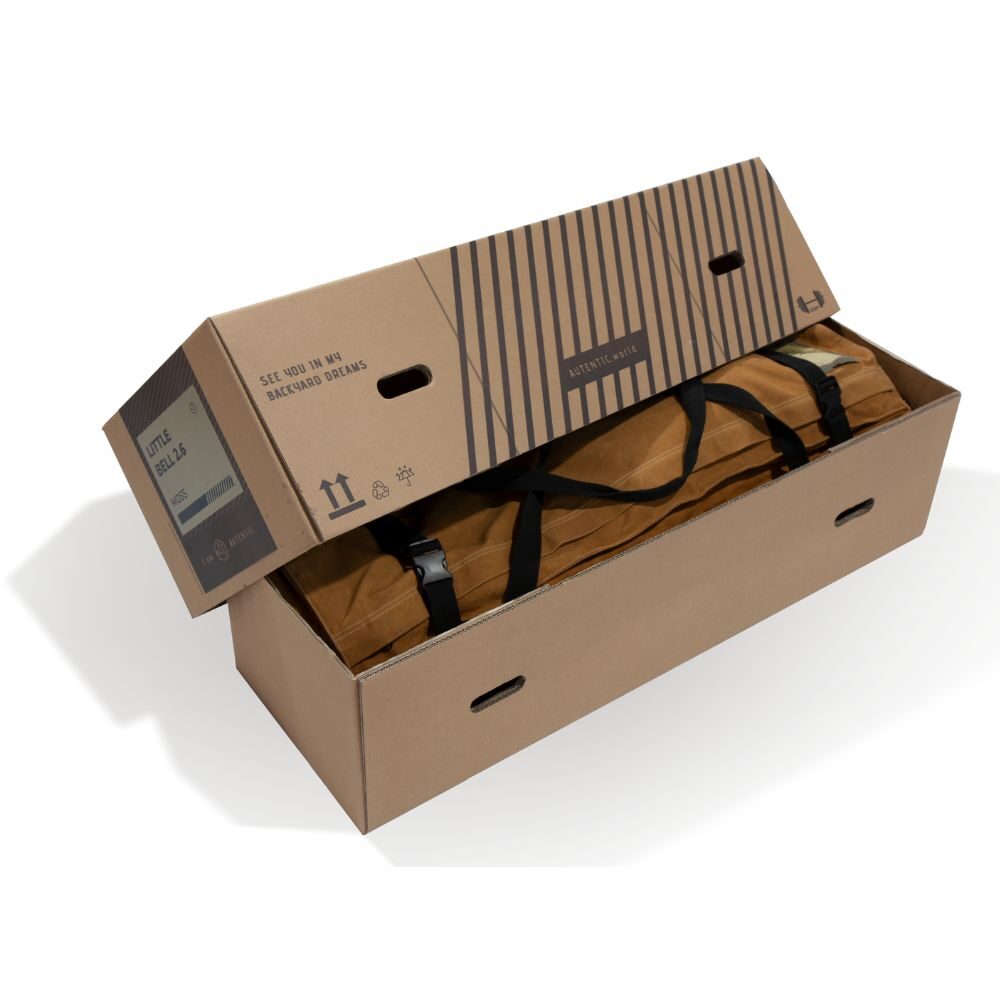
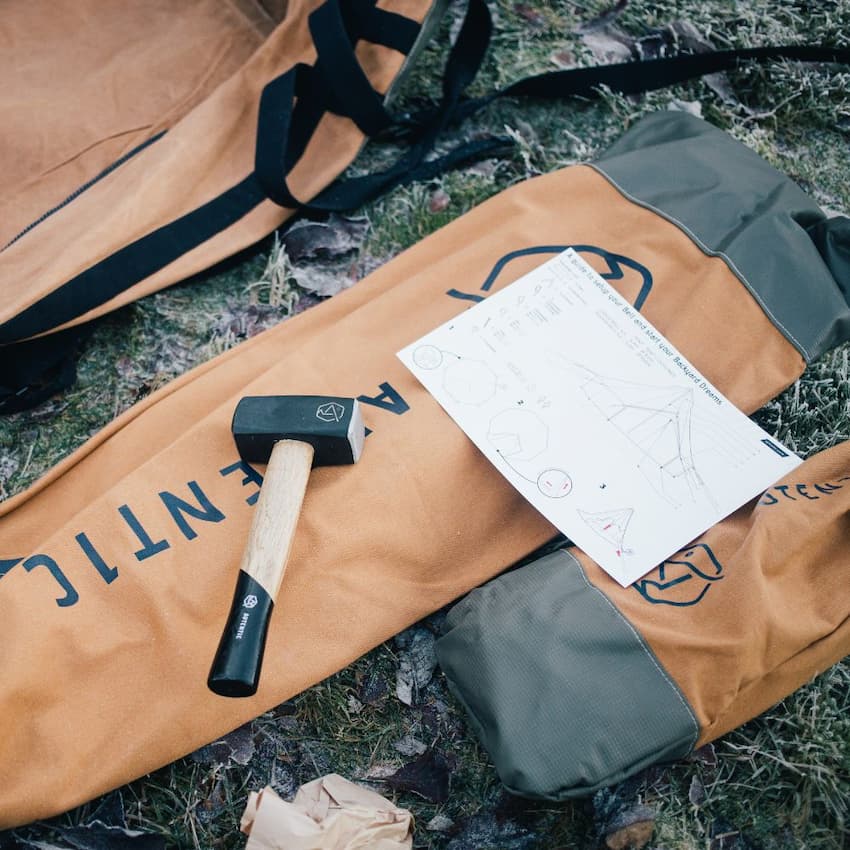
We provide simple folding instructions for all of our Autentic glamping tents to ensure they fit back into their tent bags and can be stored properly. The folding instructions can also be downloaded from the product pages on our website.
Make sure your tent is dry and clean when packed and ensure the same for the place where it will be stored.
Easier said than done? Here are some useful tips for correctly packing your bell tent.
- Tip 1: Clean your glamping tent
Cleaning products for Wottex ™ Pro
The Autentic Wottex™ Pro bell tents feature a fabric made of Acrylic material. To keep your Wottex ™ Pro bell tent in optimal condition, we suggest using two Tex’ Aktiv products. First, utilize Tex Aktiv Cleaning to remove stains from the tent fabric. Second, apply Tex Aktiv Guard, which will renew the fabric’s water-repelling properties.You can acquire both Tex’ Aktiv Clean and Tex’ Aktiv Guard directly through Autentic. For further details, feel free to contact our team at info@autentic.world.
Cleaning products for Wottex ™ and Wottex ™ FR
Both Wottex™ and Wottex™ FR are polycotton fabrics. To properly maintain and retreat your cotton-based bell tent (Wottex™ and Wottex™ FR), we recommend employing a combination of two 303 products. First, clean the tent fabric using the 303 Multisurface Cleaning solution. Then, enhance its water repellency by applying the 303 Fabric Guard Product. Autentic does not distribute the 303 products, but these items are available for purchase through a variety of online retailers.
Cleaning products for 100% Cotton
For the maintenance and retreatment of your 100% cotton bell tent, follow this two-step approach. Firstly, use the 303 Multisurface Cleaner to effectively remove stains from the tent material. Secondly, apply Ultramar, a transparent treatment product designed to restore water-repellency. Autentic does not distribute these products, but these items are available for purchase through a variety of online retailers.
Additional information regarding the application of these products can be found here.
Please note that Autentic can not be held responsible for damages or unsatisfying results caused by cleaning or re-treating your glamping tents with other products than the ones advised by us.
For additional details about cleaning your bell tent, we invite you to read our FAQ titled “How can I clean my glamping tent?”
- Tip 2: Store your glamping tent dry
After cleaning your glamping tent and its components, it’s essential to ensure everything is thoroughly dried before storing it in the tent bag. Microorganisms thrive in humid environments, making it imperative to avoid storing a wet or even slightly damp tent, as it will inevitably lead to mould growth.
Keep in mind that not only rain, but also fog and dew can make your glamping tent feel wet or clammy. In this case too, it is crucial to let your tent dry out completely before storing it.
Remember to ensure that all the components of your bell tent are completely dry before storing it. In this matter, please take into account that the guylines of your glamping tent may take longer to dry compared to the tent fabric. Therefore, we advise to take them off and store them separately.
- Tip 3: Zip up everything that can be zipped up
Before packing up your glamping tent, zip up all doors, windows, groundsheet, and anything else that can be zipped up. When everything is closed, folding the tent will be much easier, and setting it up next time will be even easier.
- Tip 4: Count your tent pegs
Always make sure to have all your tent pegs when taking down your glamping tent. Not only for yourself (so you don’t miss any the next time), but also for animals or people enjoying the area where you have camped.
- Tip 5: Store the tent components in the appropriate bags
Not only your glamping tent, but also the loose tents parts have to be handled with care and stored in bags. This prevents the tent fabric from becoming dirty by residual dirt on these parts. Another advantage is that you shorten the search for the right part for the next time you pitch your tent.
Separate storage of your tent’s guylines is highly recommended as they tend to dry at a slower rate than the tent fabric. If the guylines are still wet when you pack the tent, they can leave slightly coloured stains on the tent fabric. In addition, guylines can become tangled and make storage more challenging.
- Tip 6: Pack your glamping tent away in the tent bag
Autentic’s tent bag is made from cotton canvas. Since cotton is breathable, the provided tent bag is the best solution for packing away your glamping tent. Make sure that the bag is always properly zipped up so you’re not getting surprised by small critters during your upcoming adventures.
- Tip 7: Store your glamping tent in a high, dry and well-ventilated place
To avoid unpleasant visits from pests and the development of mould, we strongly recommend you to always store your tent bag high up in a dry and well-ventilated area.
Preferably, yes! When breaking down and storing your glamping tent, we strongly advise you to remove the guylines, let them dry when wet, and store them in a separate bag in a place where they don’t touch the tent fabric.
Why? The tent guylines tend to dry at a slower rate than the tent fabric. If the guylines are still wet when you pack your tent, they can leave slightly coloured stains on the tent fabric. Those stains don’t affect the quality of your tent, but it would be a shame to have coloured stains on such a beautiful glamping tent. In addition, guylines can become tangled and make storage more challenging.
Our guylines are attached with easy-to-use carabiners. So it’s only a couple of seconds to take them off and hang them back when you set up your bell tent!
If you do have some coloured stains, you can try to wash it off with water and a soft sponge. Don’t use a hard brush or chemicals that are not made for tent or fabric cleaning as it will wash off the treatment of the fabrics.
WEATHER
All Autentic’s tent fabrics have undergone a special water-repellent treatment, which means that the fabric repels water upon contact.
However, for tent fabrics containing cotton, it is possible that a small amount of water may pass through the tent or the tent may feel damp during its first use. This is perfectly normal, and we recommend soaking the tent before its first use to activate the cotton fibers. Natural cotton swells when wet and shrinks when dry, and this process will fully seal the tent canvas after the first use, creating a waterproof canvas tent that also reduces condensation.
Make sure to always let your glamping tent dry thoroughly before storing it to prevent the growth of mould.
It’s normal for a few drops of water to seep through the seams during your bell tent’s first use. This occurs because the production process involves stitching that creates tiny holes in the fabric. When your bell tent gets wet for the first time, the sewing thread fibers swell, filling and sealing these holes.
All of Autentic’s sewing thread is treated with an anti-wick coating to prevent water from moving through the seams. If you still notice water entering your bell tent after the initial use, we recommend applying a seam sealer on the affected area. This will add an extra protective layer to the seam to stop water entry.
We have tested multiple products and suggest using seam sealers from Fast Cure or Stormseal:
- Applying Fast Cure
This liquid seam sealant comes with a built-in brush applicator. Set up your bell tent or lay it down to access the inside seams. Lift the brush top and apply a thin layer over the seams. The sealant will cure into a waterproof barrier within a few hours, drying clear.
- Applying Stormseal
Shake the bottle and remove the cap. Pour the product into a container, cup, or dish. Use the supplied brush to apply a film directly onto the seam stitching or hole. Allow it to cure for 15-25 minutes until clear and dry.
As a general rule, our glamping tents are anticipated to withstand wind speeds of up to 80 km per hour (+/- 50 mph) for the Billy-Joe Double Bell Tent and 90 km per hour (+/- 55 mph) for the other bell tents, given that they are correctly set up and the guidelines provided in this FAQ are diligently followed. To withstand windy weather conditions, a perfect tent installation and anchoring are crucial.
It’s important to note that wind always remains a highly variable element, aside from the speed, also the location, wind directions, force, frequency and duration (winds guts versus steady winds) can have an unpredictable and different impact on the bell tent.
Here are some guidelines to adhere to when setting up your bell tent in windy conditions:
- Always make sure all doors and windows of your glamping bell tent are closed.
- Ensure that all guylines are properly tensioned to maintain stability of your tent.
- Ensure that the pegs are fully inserted into the ground.
- Make sure that the poles and frames of your glamping bell tent are consistently positioned in a perfectly vertical manner.
Regularly monitor the aforementioned guidelines and make necessary adjustments as required.
In case of heavy winds:
- If you have short guy poles, remove them and place your pegs at normal distances to absorb shocks better.
- If your tent is screen onto a wooden platform and you don’t have the option to make the guylines longer, fix the short guy poles at the bottom side to the platform to make sure it can’t move
Furthermore, we provide two additional accessories that enhance the wind resistance of your glamping tent.
-
- Heavy-duty centre pole
Thanks to its increased diameter and wall thickness compared to the standard pole, this heavy-duty pole provides enhanced resistance during adverse weather conditions and can effectively handle higher tension on the bell tent.
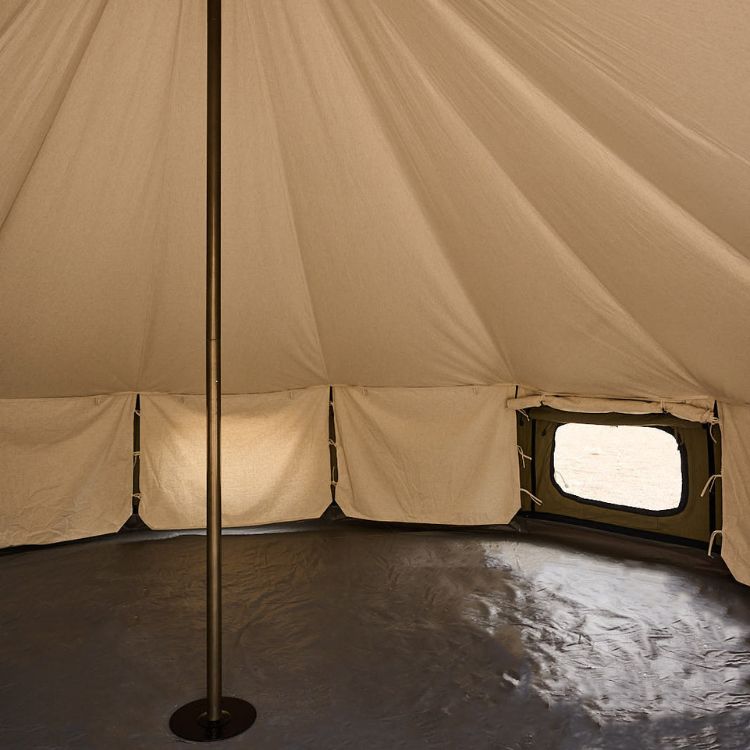
- Heavy-duty centre pole
-
- Shock absorbers
These shock absorbers help reduce stress on the bell tent’s fastening points during windy conditions, thus preventing wear to the frame and fabric. Additionally, these shock absorbers contribute to maintaining a tight pitch of your bell tent by minimising the risk of tension loss
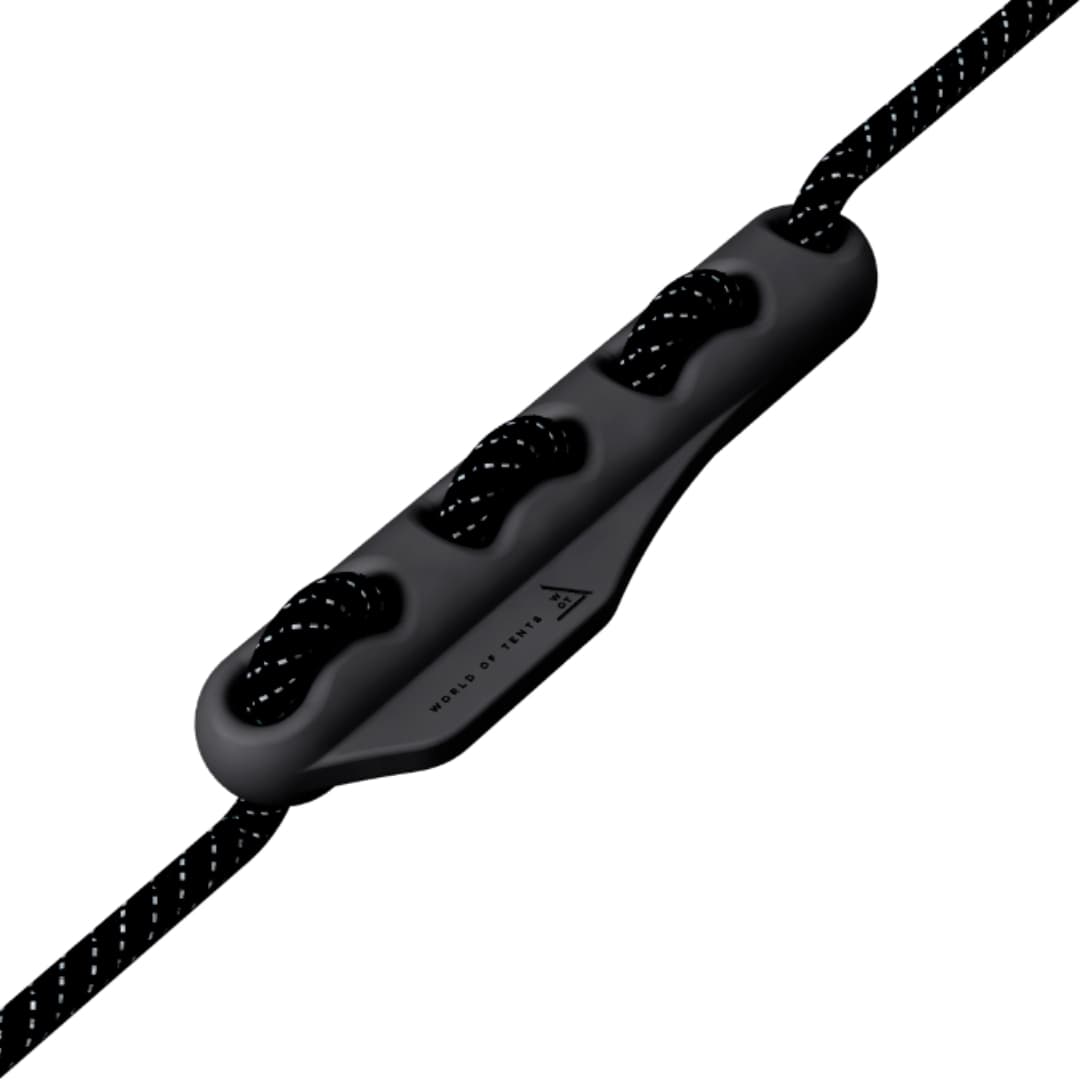
- Shock absorbers
We would like to stress the fact that the aforementioned wind resistance only applies when the tent is pitched and maintained in full accordance to the instructions supplied with the tent and our website. Autentic cannot be held liable for any damage arising or caused by the product being used or set up in contradiction to the relevant installation instructions or used for any purpose other than its intended use.
More information on the wind resistance of the Autentic Bell Tents can be found here.
While the Autentic glamping tents can be pitched in snowy conditions, it is crucial to regularly remove snow around and on your bell tent. This precautionary measure helps prevent the formation of pressure zones caused by snow accumulation, which can lead to water infiltration inside your glamping tent.
In terms of suitability for snowy conditions, the Jack Bell Tent, Jay Bell Tent, Essential 5.2 Bell Tent and Essential 4.4 Bell Tent are more appropriate compared to the Billy-Joe Double Bell Tent, as this double bell tent has larger surfaces with minimal inclination (like the roof), making it less difficult for snow to slide off. It’s worth noting that glamping tents made of the Wottex ™ Pro fabric perform better in snowy conditions compared to the 100% cotton, Wottex ™ or Wottex ™ FR glamping bell tents.
If you don’t need your bell tent during the winter season, we highly recommend breaking it down. By doing so, you can effectively maintain the longevity and condition of your glamping tent.
Absolutely! The Autentic bell tents can certainly be used in tropical regions. We highly recommend the glamping bell tents from the Supreme Collection, as they are crafted with our Wottex ™ Pro tent fabric, which is made of acrylic material. This fabric performs exceptionally well in both warm and humid environments thanks to its enhanced resistance to UV and mould.
More information about the Autentic tent fabrics can be found on our fabrics page.
The Autentic glamping tents are treated for colour fastness, but it’s important to note that over time, colour fading may occur due to prolonged sunlight exposure. The extent of fading will depend on various factors such as the specific tent fabric, the intensity of sunlight, and duration of exposure.
When considering the composition of the tent fabric, it’s worth mentioning that 100% cotton canvas glamping tents are more prone to faster colour fading up to 2 seasons, while a glamping bell tent made from our Wottex ™ Pro fabric showcases outstanding colour fastness, lasting for up to 8 seasons. Brighter colours, such as Turmeric and Roasted Pumpkin, are relatively more susceptible to colour fading compared to the more neutral Desert and Moss colours.
This fading of colour does not affect the performance, water tightness, or overall quality of your glamping bell tent.
The Autentic glamping bell tents are thoughtfully designed to provide comfort throughout the year. To ensure optimal airflow and ventilation, every bell tent is equipped with roof vents along the top. Furthermore, all bell tents feature large windows and door openings, all equipped with mosquito netting.
Additionally, we offer a range of bell tent accessories specifically designed to help you maintain a cool and comfortable environment during the summer months.
- Inner liner and air cushion ceiling
The optional inner liner in the Autentic bell tents will help regulate the temperature within the tent. Specifically, in the Billy-Joe Double Bell Tent, this inner liner acts as an air cushion ceiling, working in conjunction with the small mesh windows located at the top of the walls around the tent. This design feature facilitates airflow between the roof and the inner liner, contributing to enhanced ventilation and comfort
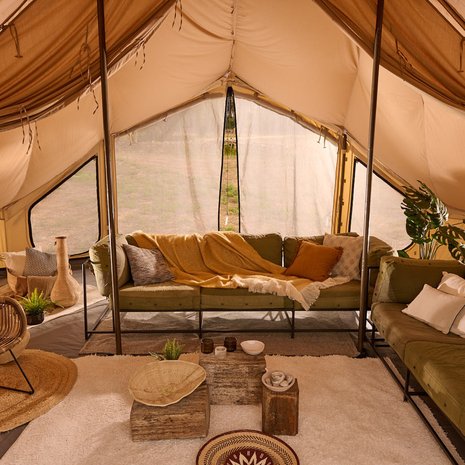
- Technical window panel
Crafted from canvas material, this technical window panel is designed with three precisely positioned holes that enable you to seamlessly guide cables and wiring into and out of your glamping tent. These openings accommodate various needs, such as routing cable for a fan or air conditioning unit.
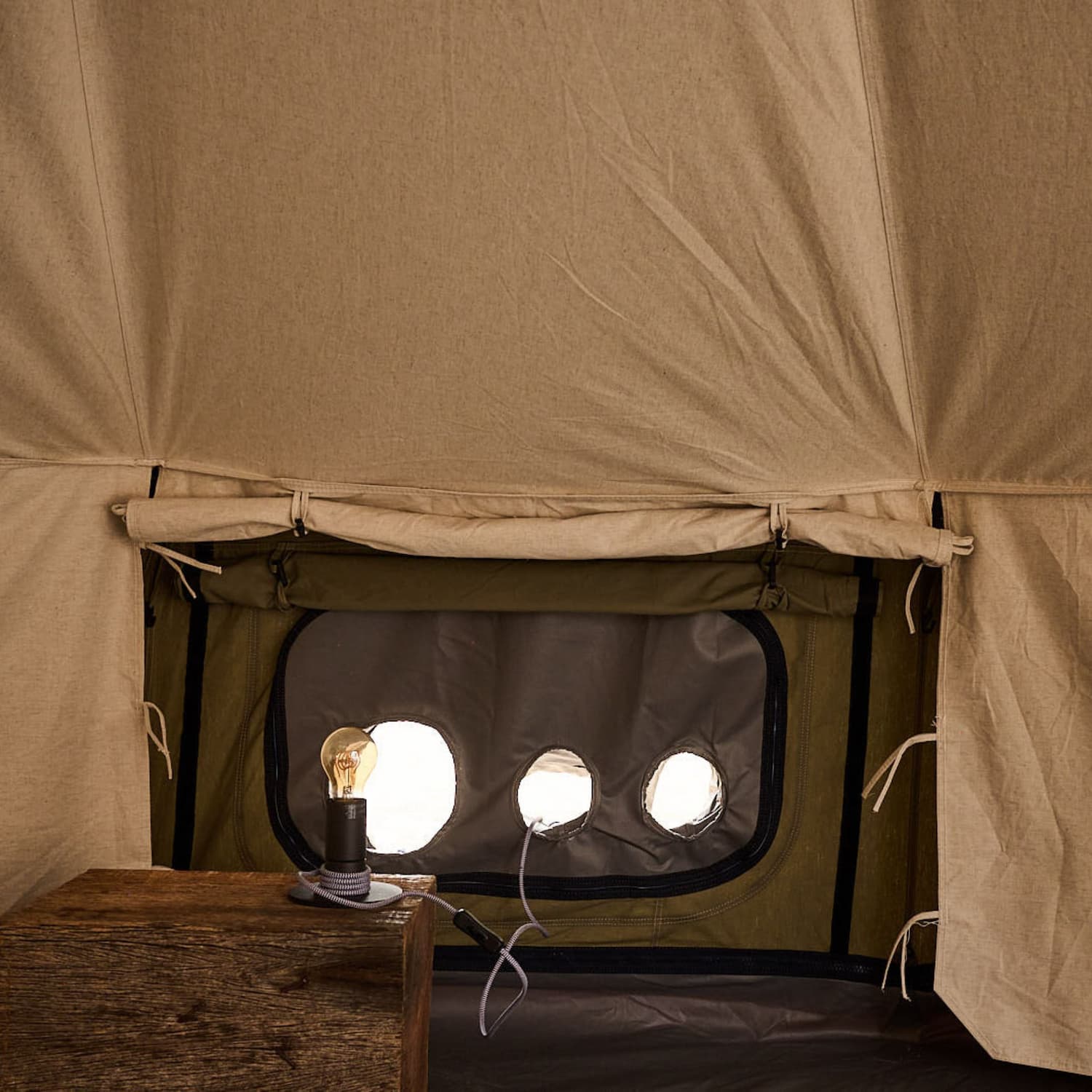
Further details about temperature regulation within your bell tent can be found here.
This is possible by using a stove. In general, we recommend two options for installing a stove inside your tent.
-
- Make a cut-out in the roof
You can easily cut a hole in the roof of your bell tent to route the stove tube vertically outside using a flashing kit. However, it’s important to consider that this solution will leave a hole in the roof of your bell tent when the stove is not needed.
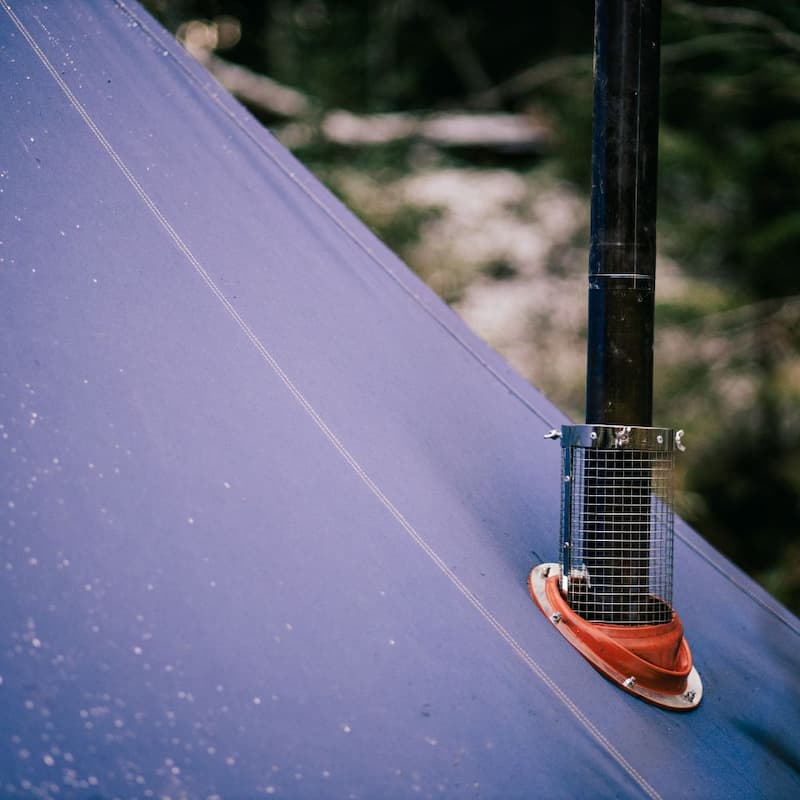
- Make a cut-out in the roof
-
- Use a stove panel
The bell tents from the Supreme Collection offer an optional stove panel that can be installed in the left front windows of the tents. To set it up, simply unzip the mosquito mesh window and replace it with the stove panel. Once in place, you can create a neatly positioned hole at the appropriate height to guide the stove tube outside your bell tent. When the stove is not needed, simply unzip the panel and replace it with the mosquito mesh panel.
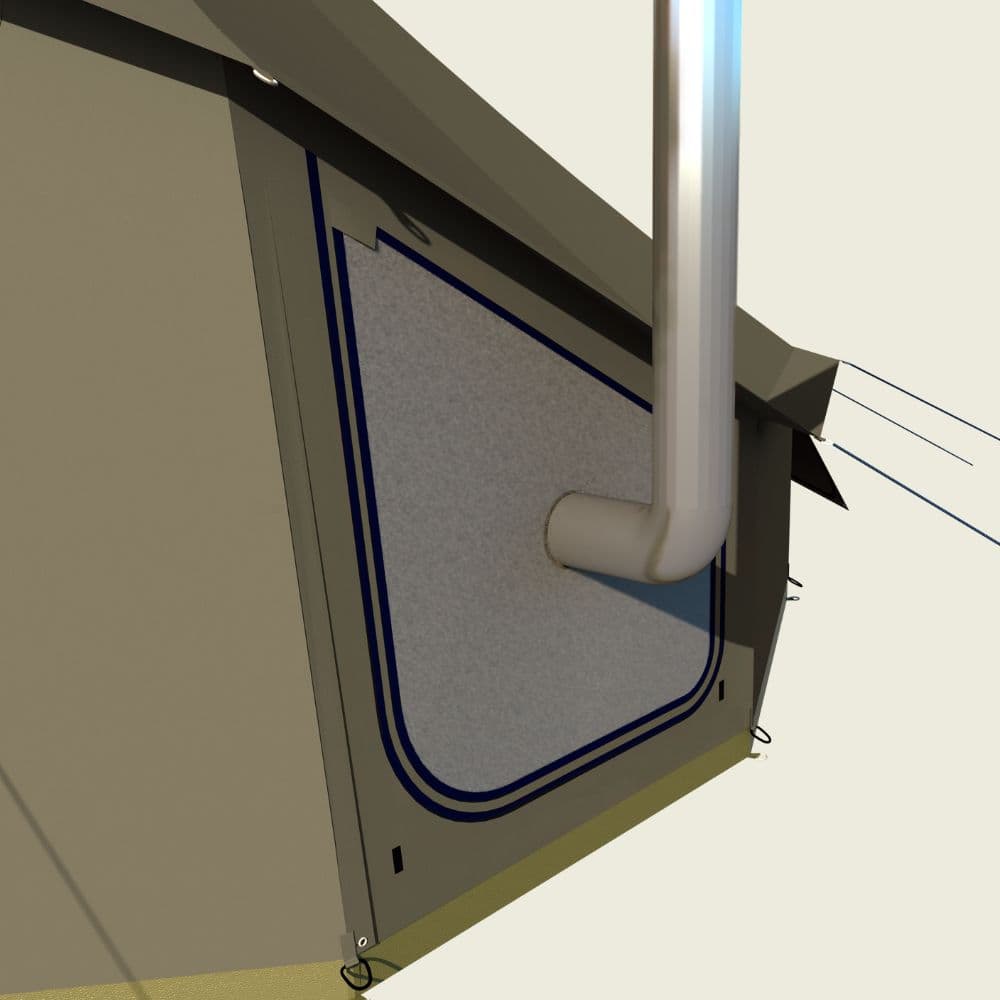
- Use a stove panel
For added safety when using a stove inside your glamping bell tent, we highly recommend opting for fire-retardant materials such as the Wottex ™ FR fabric for the tent itself and Trevira for the inner liner. It is important to have the necessary fire safety procedures in place and to install fire and gas detectors to ensure a secure environment within the bell tent.
Further details about temperature regulation within your bell tent can be found here.
It is possible to use your glamping tent throughout the year, although we recommend taking the bell tent down when you plan not to use it for a long time. This way, you can preserve its quality for longer.
If you plan to use your tent all year round, it is best to choose a tent made from the Wottex ™ Pro fabric, as it will perform better during both summer and winter.
MAINTENANCE
Regularly cleaning of your glamping bell tent is crucial to prolong its lifespan. It’s best not to delay cleaning once you spot dirt, as dirt tends to stick to existing dirt and trap moisture. Since mold thrives in damp conditions, thorough cleaning and drying of the glamping tent are essential. If you clean your tent in time, it will also take less effort to get it clean later.
Autentic has conducted extensive testing on various cleaning and waterproofing products. Depending on the specific fabric of your tent, we recommend using the mentioned products for both cleaning and waterproofing purposes:
- Cleaning products for Wottex ™ Pro
The Autentic Wottex™ Pro bell tents feature a fabric made of Acrylic material. To keep your Wottex ™ Pro bell tent in optimal condition, we suggest using two Tex’ Aktiv products. First, utilize Tex Aktiv Cleaning to remove stains from the tent fabric. Second, apply Tex Aktiv Guard, which will renew the fabric’s water-repelling properties.You can acquire both Tex’ Aktiv Clean and Tex’ Aktiv Guard directly through Autentic. For further details, feel free to contact our team at info@autentic.world.
- Cleaning products for Wottex ™ and Wottex ™ FR
Both Wottex™ and Wottex™ FR are polycotton fabrics. To properly maintain and retreat your cotton-based bell tent (Wottex™ and Wottex™ FR), we recommend employing a combination of two 303 products. First, clean the tent fabric using the 303 Multisurface Cleaning solution. Then, enhance its water repellency by applying the 303 Fabric Guard Product.Autentic does not distribute the 303 products, but these items are available for purchase through a variety of online retailers.
- Cleaning products for 100% Cotton
For the maintenance and retreatment of your 100% cotton bell tent, follow this two-step approach. Firstly, use the 303 Multisurface Cleaner to effectively remove stains from the tent material. Secondly, apply Ultramar, a transparent treatment product designed to restore water-repellency. Autentic does not distribute these products, but these items are available for purchase through a variety of online retailers.
Additional information regarding the application of these products can be found here.
We strongly advise against using a high-pressure cleaner, soap, or aggressive detergents as they can damage the tent’s fabric and shorten its lifespan. Please note that Autentic can not be held responsible for damages or unsatisfying results caused by cleaning or re-treating your glamping tents with other products than the ones advised by us.
Here are some general tips for cleaning your glamping tent:
- Clean your bell tent while it is still set up to avoid creating new stains on the fabric. If the tent is already taken down and you notice dirt, place everything on a clean plastic sheet before cleaning.
- Autentic’s Dream Collection and Supreme Collection have removable groundsheets, allowing easy removal of dirt by unzipping at the entrance.
- After cleaning, ensure the bell tent and all loose parts are completely dry before storing them.
If you have any other questions or need further assistance, please don’t hesitate to contact our team.
Autentic’s tent fabrics have undergone executive treatment – with REACH compliant finishing products – and testing to ensure they are resistant to mildew. However, it is still important to handle them with care to prevent mould growth.
It should be noted that the location of your glamping spot and the fabric composition also affect the tent’s resistance to mould. Cotton, being a natural material, is more susceptible to mould while the Wottex ™ Pro fabric has exceptional mould resistance. Have a look at our fabrics page to get to discover all the features of Autentic’s tent fabrics.
Unfortunately, there is no miracle cure for removing mould stains from your canvas glamping tent. You often read about how easy it is to remove mould from a tent fabric with chlorine, vinegar, or even sodium bicarbonate. In reality, nothing is further from the truth. Just like aggressive fungicides, these products can damage the treatment of the tent fabric, and even worse, shorten the lifespan of your glamping tent.
Since prevention is better than cure, we would like to give you some advice to prevent mould from surviving – or even appearing – on your glamping tent.
Tip 1: Store your glamping tent properly
Storing your tent dry, clean, and in a ventilated area is crucial if you want to avoid mould. Moulds love damp environments and will develop much faster in such favorable circumstances. You’ll find more tips about how to store your glamping tent correctly in our FAQ.
Tip 2: Stretch your glamping tent tightly
Always make sure your tent is stretched tensely so water can drain away from the tent fabric easily without accumulating in tiny hidden places. By using the guylines and guy line tensioners, tightening the fabric becomes child’s play.
Tip 3: Ventilate your tent as much as possible
The Autentic tents are generously equipped with ventilation holes, large windows, and mosquito mesh doors. Ventilating your glamping tent frequently will reduce the humidity inside your tent. A less humid environment means less risk of mould.
Tip 4: Take action immediately when you notice dirt
Have you noticed dirt on your tent? Clean it as quickly as possible with a soft brush or a damp cloth to prevent it from getting worse.
The tent fabric of our glamping tents has been specially treated for water-repellency, meaning that the fabric repels water on contact, while still remaining breathable. So there is no need in any sense to additionally treat your glamping tent before you start using it.
If, by any reason (after a couple of years you notice water repellency becomes less, you have cleaned the tent and removed the treatment, …), you can re-treat (i.e. impregnate) your glamping tent again for new optimal water repellency.
What’s important?
- Only use treatments of good quality. At Autentic we don’t offer treatments ourselves, but we can certainly advise you on what to use if you need it. Contact us for tips. If there is a specific area that requires re-treatment due to stain removal, we highly recommend using the Tex Aktiv Guard product.
- Make sure your glamping tent is properly set up and clean before applying the treatment.
- Ensure the product is applied evenly on the fabric by using a brush or spray.
- Don’t forget the inside of your glamping tent.
- Let your glamping tent properly dry afterwards.
The expected lifespan of your Autentic glamping tent primarily depends on factors such as the tent fabric and various external factors like sunlight exposure, radiation strength, setup location (whether on grass or near water), air pollution, duration of setup, etc.
Below, we provide an estimate of the expected lifespan (measured in professional seasons of approximately 6 months each) of the Autentic glamping tents, taking into consideration both performance and colour stability.
- Glamping tents crafted from 100% cotton canvas
Due to their natural material composition, cotton canvas glamping tents may be more prone to gradual colour fading compared to (partly) synthetic tent fabrics. This fading effect, however, does not impact their performance in terms of water resistance and resistance to mildew.Due to this, we expect the lifespan of our 100% cotton canvas bell tents to be up to 2 seasons when used temporarily and in moderate climates.
- Glamping bell tents crafted from Wottex ™
The bell tents of our Essential Collection are crafted from our polycotton Wottex ™ fabric. With the advantage of a partially synthetic composition, the Wottex ™ tent fabric offers a lifespan of up to 3 seasons when used temporarily and in moderate climates.
- Glamping bell tents crafted from Wottex ™ FR
The bell tents from the Supreme Collection are also offered in a fire-retardant polycotton fabric known as Wottex ™ FR. These glamping bell tents are designed for project-based use in moderate climates and have an expected lifespan of up to 3 seasons.
- Glamping bell tents crafted from Wottex ™ Pro
The bell tents in our Supreme Collection are additionally offered in the Wottex ™ Pro tent fabric, which is made of acrylic. This tent fabric excels in watertightness, colour fastness, and mildew resistance, making it ideal for use in all types of climates. Glamping tents crafted from Wottex ™ Pro are estimated to have an expected lifespan of minimum 8 seasons, demonstrating their durability and long-lasting performance.
In most situations, the expected lifespan mentioned above does not imply that your tent will be completely damaged or unusable after this period. We have developed and tested all of our tent fabrics in-house and in external labs, comparing them to fabrics from other bell tent suppliers in the market. We have seen our glamping tent fabrics outperforming all tested parameters (general strength, rot, mildew, water, …). As a result, we have full confidence in our products. However, we believe in providing transparent guidelines to our clients so they can make informed decisions about selecting the most suitable tent model and material for their specific needs.
Are you interested in learning more about our tent fabrics? Explore our fabrics page for additional information or get in touch with our team.
FABRICS
The Autentic glamping tents come in a selection of vibrant colours. While our tent fabrics undergo rigorous treatment and testing, it is important to note that factors such as climate, frequency of use, and the composition of the tent fabric affect its ability to maintain colour fastness against UV rays. For instance, cotton, being a natural material, may be more prone to colour fading compared to our two Wottex ™ fabrics, with the Wottex ™ Pro having an outstanding colour fastness performance.
Since the tent colours are natural, a little loss of colour intensity certainly does not make your bell tent less beautiful or affect its performance with regards to water tightness and mildew resistance.
Autentic has developed its own four unique tent fabrics, one of which is fire retardant and available for the Supreme Collection.
The Wottex ™ FR, a 380 gsm fire retardant polycotton tent fabric, has been specially designed to meet the growing demand for fire-retardant tents. This fabric adheres to rigorous safety standards such as CPAI 84 (a special regular standard for tents), NFPA 701 (US standard), and NF P92-507 (French standard for M1). If you require a fire retardancy certificate for the Wottex ™ FR, please contact our sales team.
Nonetheless, it remains important to exercise caution when using your glamping tent near a fire source.
Autentic’s Wottex ™ Pro tent fabric stands out as the most resilient option in the collection, offering several advantages:
- Unmatched resistance to UV light ensures the fabric maintains its colour even in dry and sunny environments.
- Excellent protection against mould and water, making it ideal for use in humid and tropical areas.
- High tear resistance adds to the fabric’s longevity and durability, ensuring it can withstand demanding conditions.
- The fabric’s surface repels dirt, simplifying maintenance and making it easier to clean using Autentic’s recommended products.
The Wottex ™ Pro fabric is available in two colours, Indian Bliss and Dune, and comes in two different weights. The tent walls are made from a 290 gsm uncoated acrylic fabric, while the roof is made from a 320 gsm coated acrylic fabric.
ACCESSORIES
Autentic currently does not offer interior furnishings for its glamping tents. However, if you happen to notice specific furnishings featured in our imagery, we invite you to reach out to us. We would be glad to provide you with information regarding the suppliers of those goods, helping you source the desired furnishings for your glamping setup.
Yes, this is possible in the Billy-Joe Double Bell Tent.
The Billy-Joe Double Bell Tent offers a generous area of approximately 32.6 square meters, making it an excellent choice for creating a luxurious glamping suite. To further enhance its functionality and aesthetics, optional accessories such as an inner liner and four dividers are available specifically for the Billy-Joe Double Bell Tent.
When you purchase an inner liner for this bell tent, it includes four dividers, which easily hang from the inner liner. This feature offers the flexibility to customise the space according to your needs, providing enhanced privacy whenever desired.
Both the inner liner and dividers are offered in two different fabric options: natural hemp (1) and fire retardant polyester (2). These options allow you to choose the material that best suits your preferences and needs.
(1) 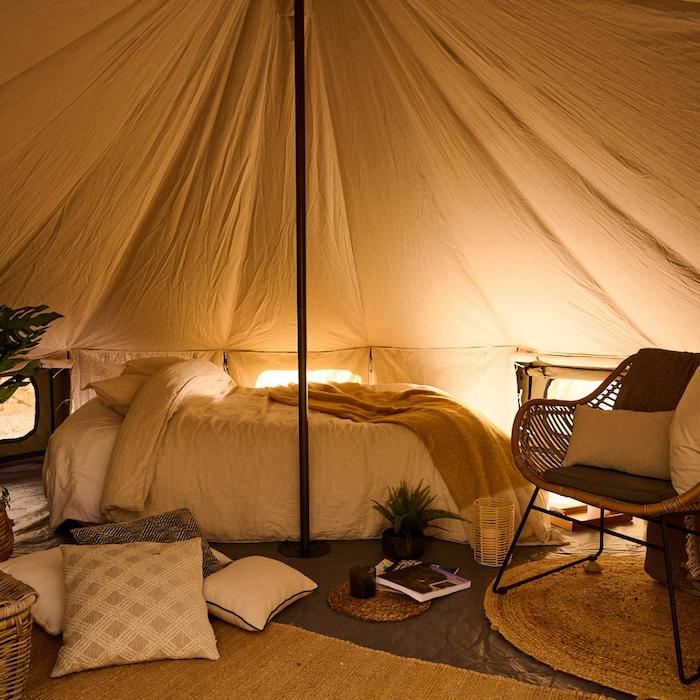 (2)
(2) 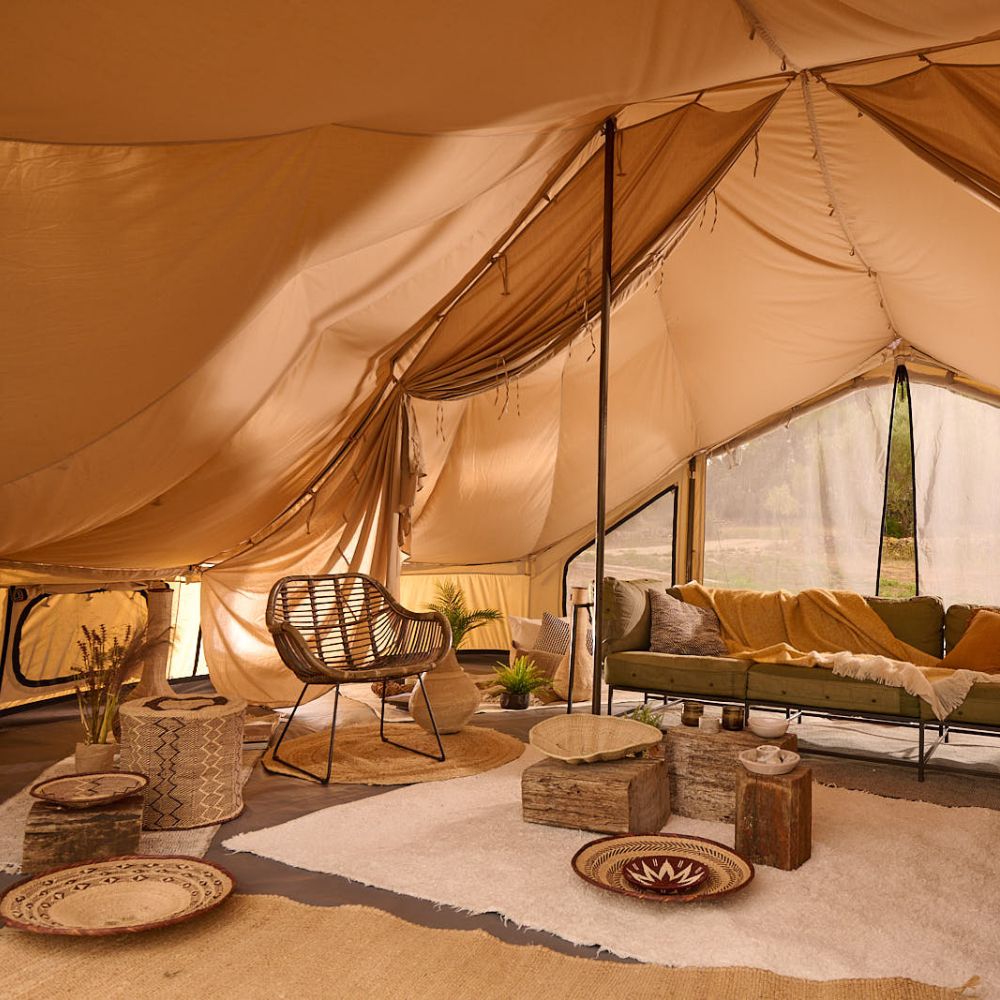
For the other glamping tents, dividers are not offered with the purchase of an inner liner.
The Autentic glamping tents do not come pre-equipped with sanitary solutions. However, our team is available to provide guidance and recommendations regarding the most suitable sanitary solution for your specific project. Whether you require assistance with portable toilets, shower facilities, or other sanitary arrangements, please don’t hesitate to reach out to us.
No, the Autentic glamping tents don’t include a kitchen or cooking facilities as part of its standard features.
For the Supreme Collection glamping bell tents, there is an optional technical window panel available. This panel is designed to fit into the side windows of your bell tent and includes three holes specifically designed for routing cables and casings. This allows for the installation of lights, air conditioning, and any other electrical devices inside the glamping tent, providing enhanced comfort for your guests.

WARRANTY & REPAIR
If you need a replacement or have any inquiries about spare parts, please reach out to the store where you bought your glamping tent. They will gladly provide you with more information and assist you in obtaining the specific parts you need for your tent.
Autentic provides a 2-year warranty on its glamping tents. However, please note that the following cases are not covered under this warranty:
- Damage to zippers, stakes and poles.
- Damage is due to wear and tear, misuse or neglect, if the defect consists of holes, damage arising from (but not limited to) mould, mildew, inconsequential spot leakage, exposure to ultraviolet light, use of fire/stove/air conditioner, other damages that may be caused by improper or negligent use/assembly/storage of the product, poor maintenance, use contrary to instructions (not following proper procedures).
- If a repair/modification/adjustment has been done by anyone other than Autentic.
- If the item has been damaged on purpose or extreme weather conditions including but not limited to ice, snow, hail, wind and lightening or any other catastrophic events.
- If the trademarks of the Autentic products and packaging have been removed.
- If the circumstance is beyond Autentic’s control such as vandalism.
- If the item has been intentionally damaged or damaged due to extreme weather conditions including but not limited to ice, snow, hail, wind and lightning or any other catastrophic event.
If you need to make a warranty claim, we kindly ask you to get in touch with the shop from which you purchased your glamping tent. They will require your tent code, which can be found on your tent ID card. Take a look at our warranty policy for more information.
All Autentic glamping tents come with a handy pocket-sized Tent-ID booklet in which you will find tips and tricks on how to prepare your glamping spot and how to best set up and store your canvas glamping tent. If you need more tips while on the road, you can simply scan the QR code at the end of the Tent-ID card or setup instructions, taking you directly to the Autentic website. You will find all our tips and tricks in the FAQ section.
Besides these useful tips, the Tent-ID booklet contains the unique code of your Autentic glamping tent. This code is needed if you ever need to claim your warranty or repair. Therefore, we advise you to take good care of this Tent-ID card. Always store it in the space provided in the Autentic tent bag. That way you can be sure you won’t lose it. Compare it to your passport. It is indispensable when travelling.
Last but not least: in the Tent-ID booklet, we’ve added a few blank pages in which you can write down all your Autentic stories and adventures. We’re always very excited to discover the Autentic camping and glamping experiences of our users. Feel free to share them with us!
Yes! All Autentic glamping tents come with a repair tape kit.
The repair tape is not shiny, so you’ll hardly notice the place where the tent has been repaired. It suited for smaller tears in canvas and in PVC groundsheet.
It is important to note that the repair tape is suited for smaller tears. In case your glamping tent is more heavily damaged, the repair tape is a good temporary solution, but we recommend you to get your tent properly repaired to enjoy it for many more years. Need advice for where to get your tent repaired? Get in touch!
STOREFINDER
Autentic distributes its glamping tents through a selective network of distributors, including both lifestyle reselling partners and professional reselling partners. To discover these distributors, we encourage you to explore our storefinder. It provides a complete listing of all the Autentic partners, allowing you to easily locate distributors, rental partners, and glamping sites who offer our glamping bell tents.
Autentic does not directly offer rental services for its glamping tents. However, we collaborate with multiple partners who provide rental services. To explore the rental options available, we invite you to visit our storefinder.
PROFESSIONAL
Do you own a campsite, an interior or outdoor design store, a camping store or anything else that could potentially match with our brand? Are you interested in working with Autentic?
We’re always very curious and excited about new partners and collaborators. Let us hear from you!
Our sales team will be happy to get to know you. Contact us via info@autentic.world.
Certainly! Autentic welcomes direct purchases from glamping sites. If you require a small quantity of tents (less than three), we typically suggest reaching out to the nearest partner in your area. However, if you have a larger order or are located in an area where we don’t currently have a partner, you are more than welcome to contact Autentic directly to discuss your requirements and make a purchase.
Autentic offers varying rates based on the customer’s profile. Resellers, who purchase glamping tents for the purpose of stocking and reselling to their own clients, are eligible for reseller pricing. In the case of projects involving three tents or more, specific project discounts are available depending on the total volume.
Reach out our sales team to obtain detailed information about the discounts applicable to your specific situation.
Would you like to see one of the Autentic glamping tents in real life?
Please take a look at our store finder where you’ll find all the locations, both distributors and glamping sites, where Autentic tents are sold or used.
The Autentic showroom, located in Ronse (Belgium), is only accessible by appointment for our B2B and B2O partners.
CORPORATE
Autentic is the newest brand from World of Tents, a group with a portfolio of six brands, all connected by their love and passion for tents. Besides this fresh newcomer providing luxury camping tents, World of Tents can rely on the long-established experience in tent development and production of its other successful and established brands.
The foundations of the group were laid in 1903 with the forerunner of today’s Alpino. This company sold industrial oils and evolved later into a saddlery. During the 1930s, the enterprise began to manufacture tarpaulins. In 1959, Alpino emerged and focused on the camping world. In 1988, the company started to manufacture folding tents under the Canopy brand. The majority of the production of these two brands is still carried out in Belgium.
Alpino’s sister company Alpinter was also founded in 1988. To this day, Alpinter is specialised in the development, production and distribution of high-quality shelter solutions and other humanitarian aid related items for emergency response. The logistical efficiency and performance of the Alpinter products have been proven many times and in various circumstances. In 2020, Shield was added to the brand portfolio. Under Shield, World of Tents develops modular shelter solutions for civil protection and military agencies.
World of Tents is continuously committed to research and development in order to perfect the quality and performance of all of its brands and better meet the needs of each of its end users. Relationships with clients, suppliers and other partners are constantly monitored. By keeping both the design and production phases in its own hands, World of Tents can always guarantee high performance products.
Are you interested in joining the Autentic team? Take a look at our job page to explore the current vacancies we have available. In the event you didn’t find the suitable match among the listed positions, but you happen to be a fan of our Autentic glamping tents, please don’t hesitate to reach out to us via email.


